Warcraft III Updated Preview
Blizzard's highly anticipated real-time strategy sequel is almost finished--and we've got in-depth gameplay details straight from the beta version to prove it.
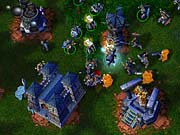
Blizzard's games always run the risk of being overexposed. It almost seems as if the company is too excited about its own work to be able to hold anything back, and fans are usually so eager to learn every detail about the company's upcoming games that, once they're finally released, it's almost as if they've been here all along. This is certainly true of Warcraft III: Reign of Chaos, which was announced in 1999 and is finally nearing completion. During these years in production, the game has transformed from what Blizzard originally dubbed a "role-playing strategy" game into a decidedly more-conventional take on the real-time strategy genre. All throughout the game's development, we've had opportunities to sit down and try the game, such as the E3 trade show in May 2001 or the European Computer Trade Show later that year. But the launch of last week's Battle.net beta program has given us ample time to really get a sense of what Warcraft III is all about.
Over the course of the next few days, we'll go into detail about a number of important new gameplay elements you probably weren't aware of, and we'll also attempt to answer that one big question: Is Warcraft III really all that different from other real-time strategy games before it? This preview will give you an overview of how Warcraft III actually plays over Battle.net. Throughout this week, we'll also have in-depth accounts of the game's four playable factions. Note that, due to the nature of this beta test, any specific details discussed in our coverage of the beta are subject to change.
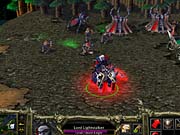
The Warcraft III beta test is playable only through Blizzard's proprietary Battle.net player-matching service, and it is intended to both test some new Battle.net features and fine-tune the gameplay balance between Warcraft III's four factions. The test has just begun, and Blizzard anticipates that it will continue for a minimum of 10 weeks, possibly up until the release of the finished product. The fact that the beta test is focused largely on game balance issues suggests that Warcraft III is already stable and running smoothly on systems that meet its minimum requirements, and in our experience, that is the case. While the beta requires a minimum of 128MB of RAM and at least a 600Mhz processor, we've found that a system meeting those requirements is able to run the game without incident. We've tested the game on a variety of setups beyond that--all the way up to a high-end Pentium 4 with 512MB of RAM and a GeForce4-based video card--and seen good performance across the board. At any rate, the beta's requirements will not necessarily be the same as those of the finished product, and Blizzard is undoubtedly still optimizing the game's performance.
Right off the bat, we were impressed with Warcraft III's presentation and production values. The game's 3D animated title screen comes up almost instantly as you load the program. The title screen's musical score is intense, prompting you to jump right in and start playing. Options for fine-tuning the graphics, audio, and gameplay settings are easily accessisble, and the loading times prior to starting a new game last only a matter of seconds. Needless to say, that's just the tip of the iceberg. Read on to find out about an important new change to the Battle.net service, as well as to learn about how Warcraft III actually plays.
Getting Right to the Point
If you've played any other Blizzard game over Battle.net, you'll be very excited to know that Blizzard will be implementing a new automated player-matching system in Warcraft III. This is similar to the system that Westwood has been using with its recent real-time strategy games. Essentially, rather than having to browse for an open game, chat with players while waiting around for others to join, and then finally get started, there's now a quick-play option that will automatically search for an open game and throw you in, no questions asked. All you have to do is choose which playable race you prefer (or pick the random option) and specify the type of game you want to play--for instance, one-on-one or two-on-two. You can also choose to exclude certain maps if you really don't want to play on them. The program will then search for a few moments to find you a suitable match, and seconds later, you'll be playing. Hopefully this automated player-matching system will also be able to pit players of similar skill levels together, based on their win-loss records. As it is, the system already works very well.
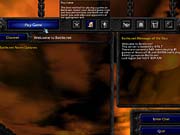
The Battle.net beta supports three-on-three matches using the automatic player-matching service, and these six-player games seem to run just as smoothly over a broadband connection as games with fewer players involved. Custom games currently support up to eight players in a single match. However, according to the readme file included with the beta, the game is intended to support as many as 12 players per game, although that number is subject to change. At any rate, eight players seems like plenty to us. There are currently only a handful of maps available for this beta test, and all of them use the same grassy plains tile set, except for one that takes place in a snow-covered area. There's currently no option to include computer-controlled players in multiplayer matches, though presumably this option will be available in the finished game.
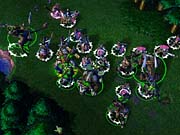
Each time you begin a match, you'll find that the entire map has been revealed for you, although you won't be able to see enemy units or structures in an area unless you move a unit to that location. This is a departure from Starcraft and Warcraft II, where maps were always covered in black fog of war at the start of a match. Having the maps revealed from the get-go seems like a good change, as it doesn't eliminate the need for effective scouting, but it does level the playing field between those unfamiliar with a particular map and those experienced with the lay of the land. Rather than having to stumble around blindly looking for more resources, you can concentrate on expanding your base of operations Still, some players will probably prefer things the old way, and Blizzard should probably give players the option to decide.
So how does this thing play, after all? Are the four factions really as different as the three sides in Starcraft? Find out what Warcraft III's factions all have in common next.
Four of a Kind
The Warcraft III beta reveals a few new previously unknown game design concepts in Blizzard's next real-time strategy game. While the four different factions play differently and all look distinct, it's clear that Blizzard tried to streamline the base-building process for all of them, simplifying it down to the essentials. Whereas in Starcraft you had to spend a lot of time building up your base, sometimes having to upgrade individual structures or build other structures that had very specific uses, in Warcraft III, all four factions follow a roughly similar building schematic.
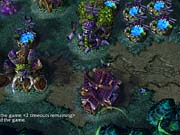
All four sides have a basic town hall structure that's the gathering point for resources and the place where new worker units, as well as hero units, are trained. As in Warcraft II, town halls can be upgraded when certain prerequisites are met, and later upgraded a second time. Worker units--the human peasant, the orc peon, the undead acolyte, and the night elf wisp--are the only units capable of building new structures. Unlike in Warcraft II, none of the races can use additional worker units to aid in the building of a new structure. However, the humans, orcs, and undead whose workers can be used to repair damaged structures, can at least use multiple workers to conduct repairs more quickly.
One of the other big changes to the base-building aspects of Warcraft III is that there is no longer a distinction between regular and advanced structures, as there was in both Warcraft II and Starcraft. Now, all the structures that a worker can construct are available on a single compact menu, and structures you can't build yet are grayed out. The game's interface is as sleek as ever. For any unit or structure that's currently unavailable to you, you can always float your mouse over its icon to learn exactly which prerequisites you need to meet before you can have access to it.
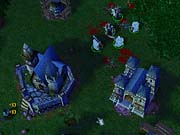
All four sides also use the same two resources--gold and wood. Gold is available from the mines that can be found on each map, while wood can be gathered from forests. Warcraft II featured a third resource, oil, which was used for building sea-faring units, but Warcraft III does away with the naval component and the corresponding resource. Each of the four factions is also subject to a supply limit, much like in Starcraft. You can't just keep cranking out new units--you must build additional farms (or your faction's equivalent) to add to your maximum supply.
For the most part, Warcraft III and Starcraft use the same point scale in their supply systems--larger units, for example, require up to eight supply points. However, whereas the supply limit in Starcraft was 200, it's currently only 90 in Warcraft III. Thus, if you're a Starcraft veteran, you'll find that you can hit Warcraft III's supply limit very quickly. It's uncertain whether Blizzard will adjust this limit, or allow users to customize it, but currently the result is obvious--the average battle in Warcraft III is on a smaller scale than the average battle in Starcraft, and you're much more likely to hit the supply limit during a given match.
Is the lower supply limit a huge step down from Starcraft? Is gathering resources the same as before? Find out next.
Supply and Demand
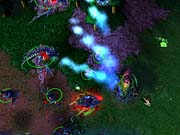
Warcraft III's supply limit is much lower than that of Starcraft, but to be fair, the game is intended to be about smaller-scale battles than Starcraft. You're dealing with fewer numbers of tougher, more powerful units in Warcraft III as compared with Starcraft. Nevertheless, in our experience with the beta, the supply limit has occasionally seemed restrictive. There's only room to field two or so average-sized armies. As such, if you're in a match with more than a few other players, you can't necessarily afford to send a large force stomping across the map--you'd be leaving yourself defenseless. If Blizzard is planning to support 12-player games, then hopefully it is also planning to allow players to have more units on the battlefield.
You don't hit the supply ceiling right away, of course. All the factions in Warcraft III are subject to the rules of upkeep, a new concept for Blizzard's real-time strategy games, though not a new concept to strategy gaming. The underlying principle is that raising an army doesn't just cost money up front, but represents an ongoing expense. Warcraft III's implementation of upkeep is actually quite simple: The larger your army is, the slower your resource gathering will be. When you begin play, a worker unit can typically haul 10 units of gold at a time. But once your army has grown to a certain size--specifically, in excess of 30 units of supply--then an upkeep penalty starts to take effect. Now you'll only be bringing in 70 percent of the resources you normally would, or seven units of gold per trip. If you exceed 60 units of supply, upkeep becomes even costlier--your take will be cut to just 40 percent. Upkeep currently isn't affecting the rate at which wood is gathered, only gold--but gold is the game's primary resource.

The point of the upkeep system is to discourage the sort of defensive behavior that plagues many other real-time strategy games. Instead of rewarding you for hunkering down and building up an unstoppable army, Warcraft III discourages you from hoarding units and resources. You can still raise a large army, but as long as it's intact, your ability to gather resources will be hampered. Your best bet is to stay on the offensive and stay out of the high upkeep zone as much as possible, basically by not being too worried about losing units. This way you'll end up having plenty of resources on hand to replenish your forces.
Though the design of Warcraft III has changed rather drastically during the course of its development, one aspect that hasn't changed is the focus on hero characters, powerful warlords who will bolster your armies' powers and help lead them to victory. Like the concept of upkeep, the concept of hero characters certainly isn't new to strategy gaming, though Warcraft III marks the first time that Blizzard has used this concept centrally in one of its games. Each faction in Warcraft III has three different types of heroes--some of these are melee fighters, others have ranged attacks, and others are skilled magic users. Heroes are the only types of units that gain experience points from battle, and when they gain enough experience, they gain a level. Gaining a level increases a hero's core attributes and also lets you choose to acquire or enhance one of several special abilities available to that hero. So how exactly will heroes figure into Warcraft III's battles? Find out next.
Heroic Undertakings
When you start a multiplayer match, you don't start out with a hero--but you do get your first one for free from your town hall. Though you can eventually have several heroes on the battlefield, chances are your first one will be your most important, so it'll be up to you to choose the one who best suits your style--and up to Blizzard to make sure every option is equally viable. At any rate, soon after you train your first hero, you'll want to send him or her out looking for adventure and valuable battlefield experience.
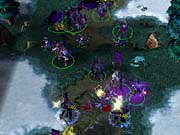
As you traverse the map with your hero, it won't take you long to find what Blizzard calls "creeps," computer-controlled monsters that you'll find just hanging around. These won't attack you unless you get close, and their inclusion is probably one of the biggest differences between Warcraft III and Blizzard's earlier RTS games. In addition to experience, heroes earn valuable items by defeating creeps, and these items can boost your heroes' core attributes, making them stronger than ever (heroes don't need to defeat creeps single-handedly, but need only be in the vicinity of the battle to earn experience). This encourages you to go on the offensive early on, because well-equipped high-level heroes are extremely powerful.
Heroes obviously aren't invincible. To discourage you from being too protective of your heroes--that is, to encourage you to use them in battle rather than hide them in the corner of the map--each faction has an altar structure that can revive slain heroes for a price that's proportional to the hero's level. The altar also serves as a prerequisite for your town hall's second-level upgrade, so you'll probably end up building one regardless of whether you want the life insurance.
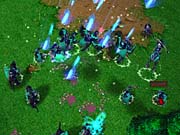
Back to the creeps--besides being fodder for your heroes, they also serve to prevent players from being too aggressive, as they will often be found guarding gold mines and other important areas of the battlefield. So chances are you won't be able to rush your opponent or expand your base within the first five minutes of the game--your attack force won't be able to get past all the creeps.
Well, not unless you move at night--Warcraft III features a day-night cycle. Every few minutes of game time, day will change to night, and then back again. In gameplay terms, nighttime reduces the line of sight of most units, and creeps also fall asleep at night--letting you either sneak past them or ambush them. Warcraft III maps also contain neutral buildings, such as merchants and mercenary camps. Here you can spend your resources on special equipment for your heroes or on recruiting units into your armies that you otherwise couldn't. For example, Warcraft II's two-headed ogre, while no longer directly affiliated with the orc faction in this sequel, can still be recruited at mercenary camps.
Aside from some of the new details, such as the heroes, it's fair to say that Warcraft III plays similarly to Blizzard's last couple of real-time strategy games. The controls and interface remain nearly identical in function--you'll still need to use the mouse in tandem with keyboard hotkeys for maximum effect. There are a few new significant interface features you can look forward to, though. They may not sound like much, but if you're a veteran of previous Blizzard RTS games, then you'll find that they'll make a huge difference in how you play the game. Find out about the new interface features and more next, in the conclusion to our Warcraft III beta overview.
Controls and Conclusion
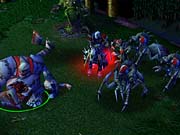
One of the notable changes to Warcraft III's interface is that spellcasting units can now be set to auto-cast one of their spells. In both Starcraft and Warcraft II, spellcasting units would do next to nothing if left to their own devices. But now, spellcasters can be effective in groups without requiring as much micromanagement as before. For instance, if you want a priest unit to auto-heal any injured unit in his vicinity, simply right-click the healing icon (once you've researched the ability) and the priest will diligently heal his allies. You'll still need to micromanage your spellcasters for maximum effect, but being able to auto-cast certain spells makes your casters seem much more effective.
Another new interface feature is the addition of subgroups. Much like previous Blizzard real-time strategy games, Warcraft III puts a rather strict limit on how many units you can have selected at a time--you can select up to 12. By now, most real-time strategy games require you to use a combination of unit types to succeed. Sometimes this means you have to fumble around in the middle of battle, trying to keep all your unit types in line--your melee units in the thick of it, your ranged units behind them, and so on. Warcraft III lets you easily switch between unit types in a group by using the Tab key. The Tab key automatically cycles through all units of a type within the group, so that you can issue orders to certain members of a group without deselecting everyone. This shortcut should be useful in the heat of battle.
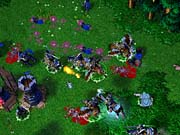
Warcraft III definitely looks promising--it's already fun to play and it looks great. How much fine-tuning will occur over the course of the beta test is anyone's guess. But clearly, there's a lot that needs to be tested and refined. For instance, unit pathfinding can be problematic--friendly units won't make way for one another. Also, besides the possible issue with the relatively low supply limit, currently the game's battles tend to be rather fast--you don't necessarily get the sense that your units are individually powerful, as even heroes can be defeated pretty quickly. Whether this is as intended or not, you can be sure Blizzard will be closely monitoring beta testers' feedback in determining how to tweak the gameplay from here on out.
This preview gave you an overview of how Warcraft III actually plays at this point and of some of the previously unrevealed features both in the game and in the Battle.net service. What we didn't cover in any great detail are the game's four playable factions. What you know from this preview is that they have a few basic things in common--they all use the same resources, for example. But over the next few days, we'll go into depth about the humans, the orcs, the undead, and the night elves to give you a close look at all of them and also demonstrate just how different they really are. Keep up with GameSpot's coverage of Warcraft III all this week, and you'll see why there's good reason to be excited about this highly anticipated game.
Got a news tip or want to contact us directly? Email news@gamespot.com
Join the conversation